eISSN: 2093-8462 http://jesk.or.kr
Open Access, Peer-reviewed

eISSN: 2093-8462 http://jesk.or.kr
Open Access, Peer-reviewed
Jaein Lee
, Minju Kim
, Sung-Hee Kim
, Ara Cho
, Inho Lee
, Jiyoung Han
, Sunjoo Kim
, Youngjae Im
10.5143/JESK.2023.42.6.639 Epub 2024 January 07
Abstract
Objective: The goal of this study is to develop an evaluation index to lay the foundation for a system that evaluates the quality of the user's experience with products to which CMF design is applied. In addition, it is also to develop quantified evaluation indicators by analyzing the developed index from the perspective of an actual specific product group.
Background: A variety of research on the subject of evaluating specific targets is being conducted, and in relation to this, there are many existing studies on product evaluation, evaluation systems, CMF design, and CMF design products. However, there is not much research on the evaluation of experience quality for products with CMF design, which is one of the important elements in the design field.
Method: A systematic approach was taken by dividing it into two major stages. In the first stage, final indicators were derived from basic data collection as the primary outcome. First, the literature is selected using the PRISMA method based on systematic literature review reporting guidelines, the basic data of the evaluation indicators are collected, the results are organized based on the affinity diagram, and the final indicators are verified through expert review. In the second step, a second affinity method is performed and 22 specific indexes on home appliance are derived, and a fitness analysis is performed on these indices with the CMF design experience quality from the perspective of the kitchen appliance product line, and the results are obtained. An ANOVA was performed on the results to derive final indicators organized by priority.
Results: In the first step, final indices were derived as the primary outcome. This final indicator has 69 detailed indicators, all of which can be used as evaluation indicators and can be used selectively depending on the evaluation object. In the second step, a secondary affinity method was performed on the primary 69 detailed indicators to derive 22 specific indexes on home appliance, and a fitness analysis of these indicators with the CMF design experience quality from the perspective of the kitchen appliance product line was conducted. Final Specific Indexes on home appliance organized by priority were derived from the results of the evaluation.
Conclusion: Although there are many existing studies on product evaluation, evaluation system, CMF design, and CMF design products, there is a lack of research on experience quality evaluation of products to which CMF design is applied. Therefore, we conducted a systematic study on this and derived indicators that can be applied in practice and it has meaning as worth studying.
Application: The indicators for the kitchen appliance product line derived from this study can be selected and immediately applied according to priority when evaluating the quality of the CMF design experience of the product, and can also be selectively applied to other products through an evaluation of suitability with the corresponding product. It has high field applicability in related research and practice.
Keywords
CMF design CMF design product User experience quality Evaluation index Indexes on home appliance
특정 대상을 평가한다는 것은 그 대상에 대해 수준을 정하고 그 수준에 맞춰 다양한 활용을 한다는 의미가 포함된다. 이 평가의 대상물은 공공 정책(Kim and Gong, 2013)부터 일반 제품은 물론 무형의 서비스(http://ks-sqi.ksa.or.kr)까지 다양하다. 이러한 대상물에 대한 평가 주제는 많은 문헌에서 다루고 있다. 대표적으로 김민주 외(Kim et al., 2022)에서는 시니어용 디스플레이와 관련된 경험 요소의 품질을 평가하기 위한 지표(Index: 이하 본문에서는 '지표'로 통일)를 개발하였다. Duanmu et al. (2017)은 Streaming Video에 대하 경험 품질 평가를 위한 지표를 개발하였다. 그 외에도 다기준 의사결정 방법을 활용하여 사용자 경험에 대한 평가 방법(Lee et al., 2022), 웨어러블 로봇에 대한 사용성 평가 가이드라인(Bae et al., 2020), 병원 내 공기질에 대한 감성 평가(Kim et al., 2020), 인지 부하에 대한 평가 방법(Mun, 2018), 대학 교육의 품질에 대한 만족도 평가 지표를 개발(Bertaccini et al., 2021) 등 주제와 방법들이 다양하게 이루어지고 있다. 그리고 대상물 평가 방법에서 정량화하여 객관적으로 평가하려는 연구도 많다. 대표적으로 Jung (2017)은 사용성 평가 지표를 사용하여 지하철 노선도의 시각적 디자인에 대하여 정량적으로 평가하였다. 그 외에도 QFD 방법을 사용하여 위험성 평가 방법을 재분류하고 정량적 특성 평가를 연구하거나(Kim et al., 2022), 소비재 제품의 사용자 경험 인증 평가를 수행하기 위한 평가 체계를 개발하면서 정량적인 접근을 하였다(Song et al., 2019). Shin (2015)은 스마트폰에 대한 사용자 경험 만족도를 또한 일반적 디자인의 감성만 족도를 평가하기 위하여 부분 최소 제곱법을 활용한 지표를 사용하였다. 시선 엔트로피를 정량적으로 활용하거나(Lee et al., 2020) SUV 차량의 외관 감성을 평가하는데 시각적 주목도 등의 정량적 접근을 하기도 하였다(Lee and Jung, 2021).
한편, CMF 디자인은 제품디자인 분야에서 중요한 요소이고 산업적으로도 많은 연구가 있다(Sung and Nah, 2018 등 다수). 여기서 CMF 디자인은 Color, Material, Finishing을 공간/제품/환경에 적용하는 총체적 디자인을 이른다(Shin, 2019). 그리고 CMF 디자인 제품은 CMF 디자인이 적용된 결과물로 정의할 수 있고, CM 디자인 제품 경험 품질은 특정 환경 내 공간에서 대상 제품에 대하여 느끼는 개인의 감성과 CMF 요소간 결합에 기인한 총체적 경험 품질로 정의할 수 있다. 이 CMF 디자인과 그것이 적용된 제품과 관련된 연구는 많지만 이것에 대한 경험 품질 평가에 대한 연구는 많지 않다. Kang et al. (2023)은 CMF 디자인과 제품의 경험 품질 등의 개념을 정리하고 있다. 이 연구 또한 이 주제와 관련된 개념을 체계적 문헌 고찰을 통해 정리한 정도이다. 그래서 본 연구에서는 CMF 디자인의 이러한 평가 체계의 기반을 다지기 위하여 평가 지표를 개발하는 것으로 목표로 한다. 개발한 Index를 대상으로 실제 특정 제품군의 관점에서 분석하여 정량화된 평가 지표도 개발한다. 특히 본 연구는 경험 품질의 핵심 표현이 되는 감성 어휘를 한글에 기반한 어휘 중심으로 하여 평가 지표를 도출하고자 한다. 이를 위해 국내 문헌 중심으로의 데이터를 기반으로 한다.
본 연구의 핵심은 실제 연구나 실무에 사용할 수 있는 현실적인 평가 지표를 도출하는 것이다. 그리고 체계적으로 도출해 나가는 과정이 중요하고 그 과정의 체계성이 또한 이 연구의 핵심이다. 이를 위한 연구를 크게 2개 단계로 나누어서 진행하였다. 첫 번째 단계는 기본 데이터 수집부터 1차 결과물로서 최종 지표를 도출하는 것이다. 먼저 전반적인 평가 지표의 기본 데이터를 수집하기 위하여 체계적 문헌 고찰 보고지침(Reporting Guideline)에 기반한 PRISMA 방법으로 문헌을 선별하였다(Moher et al., 2009; Lee, 2020). 이 결과는 방대하고 중복된 데이터들이 포함하고 있기에 이것을 정리하기 위하여 친화도법(Affinity Diagram)을 수행하고 그 결과에 대해 전문가 리뷰(Expert Review)를 거쳤다. 이렇게 하여 1차 결과물로서의 최종 지표(Final Indexes)를 도출하였으며 이것은 연구의 정성적 결과로서 의미가 있다. 또한 이것의 세부 지표가 69개로 모두 평가 지표로 사용할 수 있는 것이고 평가 대상물에 따라 선택적으로 사용할 수 있다.
그래서 다음으로 두 번째 단계에서는 2차 친화도법을 수행하고 도출된 결과 지표를 대상으로 특정 제품군의 관점에서 CMF 디자인 경험 품질과의 연관성 분석(Association Analysis)을 수행하였다. 이 과정은 1차로 도출한 지표를 대상으로 특정 제품군의 관점에서 실제 사용할 수 있는 Index로 정리한 것이라고 할 수 있다. 이 절차는 Figure 1에 도식화하였다.
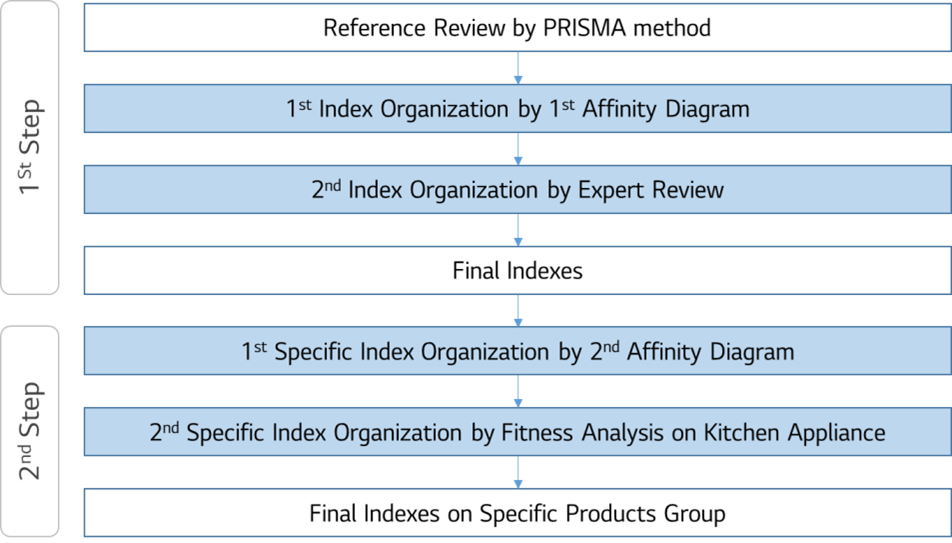
3.1 1st Step
3.1.1 Reference review by PRISMA method
CMF 디자인 제품 관련 경험 품질 평가 지표를 개발하기 위해 CMF 디자인 제품의 특성과 관련하여 연구를 진행한 국내 문헌을 중심으로 분석하였으며 연구에 활용될 문헌은 Dbpia 데이터베이스를 활용하여 수집하였다. 이 과정에서 Figure 2와 같이 체계적 문헌 고찰 보고지침(Reporting Guideline)에 기반한 PRISMA 방법을 활용하였다(Moher et al., 2009; Lee, 2020).
문헌검색에서 사용된 검색어로는 'CMF', '색 감성 평가', '소재 감성 평가', '마감 감성 평가'의 4개를 사용하였다. 그 결과 총 478편의 문헌이 검색되었다. 이 중에서 KCI 등재지가 아닌 문헌을 208편을 제거하였다. 다음으로 중복된 문헌 11건 제거하고 제목과 초록 내용을 검토하여 본 연구의 핵심인 CMF와 제품과 관련 없는 문헌을 185편 제거하여 74편의 문헌을 선별하였다. 이 74편에 대해서는 연구 내용을 자세히 검토하였으며 그 과정에서 CMF와 관련없는 문헌 13편, 제품에 대한 내용이 아닌 문헌 12편을 추가로 제외시켰다. 그 결과 총 49편의 문헌을 본 연구의 최종 검토 문헌으로 선정하였다(Table 1, 저자 ABC 순 표시).
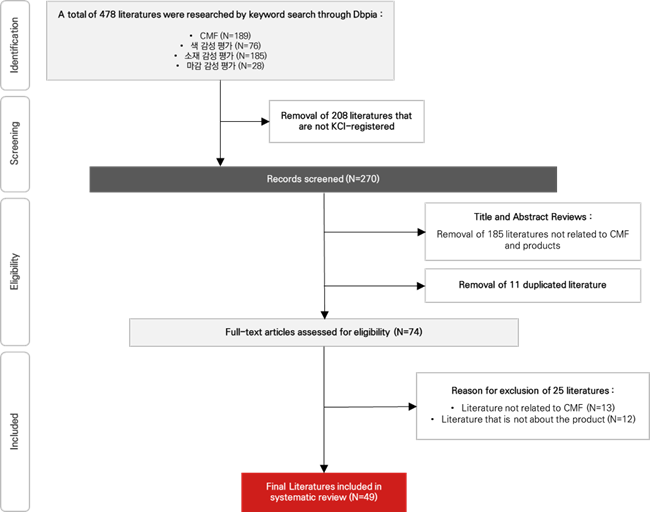
|
Bae and Kim, 2013; Guo and Choi, 2020; Ha, 2015; Han, 2021; Hyun
et al., 2016; Jeon, 2018; Jin
and Cho, 2011; Joo, 2014; Joo, 2016; Jung et al., 2008; Kang and Yi, 2021;
Kim and Park, 2016; Kim et al., 2020; Kim and Nah, 2014a; Kim and Nah, 2014b;
Kim, 2017; Kim and Choi, 2012; Kim and Choi, 2018; Kim and Lee, 2019; Kwon,
2020; Lee and Kim, 2018; Lee, 2021a; Lee, 2015; Lee, 2020; Lee and Seo, 2020;
Lee, 2021b; Li and Sang, 2021; Oh, 2020a; Oh et al., 2014; Oh and Lee, 2017;
Oh, 2018; Oh, 2020b; Park, 2016; Park, 2017a; Park, 2017b; Park, 2012; Ryu
and Kim, 2019; Seo, 2022; Shin, 2019; Song, 2021; Sung and Nah, 2018;
Wang and Kim, 2021; Wang and Sun, 2019; Won, 2015; Won, 2016; Won and Suh,
2020; Yang, 2017; Yeo et al., 2011; You, 2012 |
49편 문헌에서 본 연구의 주제에 맞는 감성 요인과 CMF 요인과 조금이라도 관련된 keyword를 모두 도출하였으며 그 결과 1,163개가 나왔다. 이 중 일부를 Figure 3에 나타내었다. 그리고 '요인'이라는 용어는 본 연구의 결과에 해당하는 지표가 정리되기 전 중간 단계의 요소들을 지칭하는 것이다.

3.1.2 1st Index organization by affinity diagram
1단계에서 선별된 1,163개 남짓의 요인은 중복된 것들도 있을 뿐 아니라 비슷한 것들끼리 묶어 체계화하는 것이 필요한 Raw Data수준이다. 이것을 정리하기 위하여, 이 상황에서 많이 사용하는 친화도법(Affinity diagram)을 이용하였다. 친화도법은 Data를 정성적으로 분류, 체계화하는데 많이 사용된다. 특히 사회과학이나 디자인 분야에서 사용되는 방법론으로 다양한 데이터를 추려서 의미 있는 데이터로 정리하는데 사용된다. 일반적인 과정은 먼저 keyword 형태로 된 데이터들을 나열한다. 그 데이터들을 유사한 특성이나 개념 등의 관점에서 그룹화한다. 그리고 그 과정을 계속 반복하면서 최종 그룹화한다. 그룹화된 데이터들에 대표 명칭을 남긴다. 이 과정이 정성적으로 이루어지는 단점이 있기는 하지만 크고 다양한 데이터들을 1차적으로 추려 나가는데 효과적인 방법이다(Chun, 2018; Korea Institute of Design Promotion, 2019).
이를 본 연구에 적용하여 1) CMF 디자인 경험 품질 영향 요인 기준 중복 제거, 2) 유사 요인 그룹화, 3) 정리된 요인 그룹에 대한 명칭 부여 등의 과정을 진행하였다. 도출된 내용을 Figure 4와 같이 1차 지표로 정리하였다. 1차로 정리된 지표는 모두 373개이며, 이것을 그룹핑한 상위 그룹은 감성 Image, Material, Finishing, 기타의 4개로 분류하였다. 그리고 감성 Image에는 시각적 감성과 촉각적 감성의 2개 하위 그룹이 생성되었다.

3.1.3 2nd Index organization by expert review & 1st indexes
1차로 정리된 373개의 지표가 연구 결과 및 일반적 평가 지표라고 하기에는 여전히 많고 유사한 것들도 있으며 특히 4개의 상위 그룹과 2개의 하위 그룹으로 구분한 것에 대한 논리적 보완이 필요한 상태이다. 그래서 전문가 리뷰를 수행하였다. CMF 디자인 및 관련 분야 전문가 3명에게 1차 정리 지표와 그룹핑 결과를 제시하고 지표 자체의 보완 사항, 그룹핑 결과의 보완 사항, 이후 지표 정리 방향 등에 대한 리뷰를 수행하였다. 전문가 3명의 경력 및 분야, 그리고 리뷰 내용 등은 Table 2에 정리하였다.
전문가의 의견은 다음과 같은 내용으로 반영하였다. 먼저 '경험 품질 평가 지표'라는 연구 목적에 맞게 Material, Finishing 등 CMF 자체의 특성과 관련된 지표는 제거하였다(전문가 C). 다만 각 Material, Finishing 특성을 반영할 수 있는 지표는 계속 유지되어야 한다. 예를 들면 탄력감 같은 것은 유리나 메달 소재와는 거리가 있지만 천이나 고무 소재에는 해당되므로 지표로서 의미가 있다는 것이다(전문가 E). 다음으로 Emotional Image에는 나중에 선별하다가 제외될 때 되더라도 기본적으로 일단은 인간의 오감을 다 포함하는 것이 논리적으로 맞다는 의견(전문가 A)에 따라 시각, 촉각 만이 아니라 청각, 미각, 후각도 따로 그룹화하였다. 또한 오감 외 제품을 사용하는 과정에서 느낄 수 있는 경험을 나타낼 수 있는 인체공학적 감성과 CMF 디자인이 포함된 제품의 사용 환경에 따라 경험이 달라질 수 있으니 그것을 고려할 수 있는 맥락적 감성도 별도로 그룹핑을 할 필요가 있었다(전문가 B). 후각, 촉각, 미각의 3개 감각은 CMF와의 관련성이 상대적으로 낮을 수 있으며 직접적인 감각이라기보다는 시각, 청각 대비 간접적인 감각이므로 이후에 특정 대상으로 지표를 선정할 때는 '공감각 감성' 정도의 그룹으로 묶어도 된다는 의견도 있었다(전문가 D). 그 외 각 전문가는 세부 지표들을 검토하여 추가하거나 제외하는 등의 의견을 주었다.
|
Experts |
Years of |
Professional field |
Comments |
|
A |
34 years |
CMF design & Evaluation system |
Since the experience may vary depending on the usage environment
of the product including ergonomic sensibility and CMF design, which can
represent the experience felt in the process of using the product other than
the five senses, it is necessary to separately group contextual sensibility
that can take these into consideration. |
|
B |
17 years |
CMF design & Color |
It is logical that Emotional Images basically include all five
human senses, even if they are excluded later when selected. |
|
C |
20 years |
CMF factor design & Mass production development |
In line with the research purpose of 'experience
quality evaluation indicators', indicators related to the characteristics
of the CMF itself, such as materials and finishing, need to |
|
D |
25 years |
Human factors & Experience quality evaluation system |
Since the three senses of smell, touch, and taste are indirect
senses from a CMF perspective, they can be grouped into 'synesthesia'
when using specific products in the future. |
|
E |
33 years |
Material & Finishing R&D |
Indicators that can reflect the characteristics of each material
and finishing must be maintained. |
이러한 전문가 자문 내용을 바탕으로 지표를 모두 69개로 정리하였으며 이 결과는 본문에 제시할 정도로 추려졌음을 감안하여 Table 3으로 전체 데이터를 나타내었다. 그리고 이 지표들의 명칭은 '1st Indexes'로 하여 1차 결과물의 성격을 부여하였다. 또한 각 지표에 대한 설명도 다양한 문헌과 전문가 의견을 참고하여 구체적으로 표현하였다.
그리고 전문가 리뷰 의견에 근거하여 이 지표는 대분류(본능적 감성, 인체공학적 감성, 맥락적 감성), 중분류(시각, 촉각, 청각, 후각, 미각), 그리고 69개 세부 지표로 체계를 갖추어 정리하였다.
|
Major |
Middle category |
Minor category |
Meaning |
|
Instinctive |
Visual |
독창성(originality) |
The degree of unique emotion felt
in the product's various colors and patterns when seen with the naked eye. |
|
일체감(sense of unity) |
The extent to which the color of
the product and the finish of the material come together and feel like one. |
||
|
세련감(sophistication) |
Degree of sensory impression of the
product when seen with the naked eye |
||
|
고급감(luxuriness) |
The degree of luxuriousness of the
product when seen with the |
||
|
심플함(simplicity) |
Degree of
neatness and cleanliness when seen with the naked eye |
||
|
친숙성(familiarity) |
Degree of
familiarity when seen with the naked eye |
||
|
단순성(clearness) |
When viewed
with the naked eye, the nature of the product is not complicated and feels
simple. |
||
|
시인성(visibility) |
The degree
to which a shape or color is easily visible to the naked eye |
||
|
입체감 |
Degree of
feeling of seeing an object with three-dimensional spatial volume |
||
|
생동감(vibrancy) |
The degree
to which a product feels dynamic when viewed with the naked eye |
||
|
차분함(calmness) |
The degree
to which the product calms and calms the mind when seen with the naked eye. |
||
|
광택감(glossiness) |
The degree
to which the product surface appears shiny when seen with the naked eye. |
||
|
모던함(modern) |
The degree
to which the product feels comfortable and dignified when viewed with the
naked eye. |
||
|
선명함(clarity) |
The degree
to which a product is refreshing and distinct when viewed with the naked eye
and cannot be confused with something else. |
||
|
신비감(mystique) |
The degree
to which a product feels fantastic when viewed with the naked eye. |
||
|
화사함(brightness) |
The degree
to which a product appears colorful and bright when |
||
|
차가움(coldness) |
The degree
of coolness and coldness felt by the product when |
||
|
강렬함(intensity) |
The degree
of staleness and harshness felt by the product when viewed with the naked
eye. |
||
|
따뜻함(warmth) |
The degree
to which the product feels soft, warm and comfortable when viewed with the
naked eye. |
||
|
순수함(innocence) |
The degree
of purity felt by the product when viewed with the |
||
|
Tactile |
두께감(thickness) |
The degree
to which a product is considered thick when felt |
|
|
탄력감(elasticity) |
The degree
to which the feeling of contact with the skin feels like a spring or that it
has the force to hold on tightly. |
||
|
매트함(matteness) |
The degree
to which the surface of a product is felt by the skin and |
||
|
무게감(heaviness) |
The
appropriate weight of the product felt by the skin |
||
|
거칠감(roughness) |
The texture
of the surface of the product that is felt by the skin is rough and not fine. |
||
|
안락감(comfortness) |
The degree
to which the body and mind feel comfortable and pleasant when touching the
skin. |
||
|
단단함(firmness) |
The degree
to which the product feels firm and sturdy on the skin rather than being soft
or soft. |
||
|
뻣뻣함(stiffness) |
The degree
to which the product feels firm and sturdy on the skin. |
||
|
부드러움(softness) |
The feeling
of the product touching or rubbing against the skin is |
||
|
온도감 |
How warm or
cool the product feels when it touches or touches |
||
|
매끈함(smoothness) |
The feeling
of touching the skin is soft and smooth without any roughness. |
||
|
유연성(flexibility) |
The feeling
of touching the skin is soft and not hard. |
||
|
Auditory |
직관성(Intuitiveness) |
The degree
to which sounds can be heard clearly |
|
|
안정감(stability) |
The degree
of physical or mental comfort and tranquility felt by hearing a sound |
||
|
자극성(irritability) |
Degree of
mental response to sound |
||
|
복잡성(complexity) |
Degree of
anxiety and confusion due to the entanglement of |
||
|
쾌락성(pleasureness) |
The level
of pleasure and pleasure experienced through sound |
||
|
활동성(activeness) |
The degree
of dynamism and grandeur felt in the sound. |
||
|
Gustatory |
대비감(contrast) |
The degree
to which the taste of the main taste ingredient becomes stronger when several
different taste ingredients are mixed together |
|
|
억제감(restraint) |
The degree
to which the taste of the main taste ingredient is weakened when different
taste ingredients are mixed together |
||
|
상승감 |
The degree
to which when two types of taste ingredients with the same type of taste are
mixed together, the taste is felt much |
||
|
상쇄감(cancel
out) |
The degree
to which the unique taste of two ingredients cannot be expressed by mixing
them, but is weakened or disappears. |
||
|
변조감(modulation) |
The degree
to which one taste cannot be perceived normally immediately after tasting
another taste. |
||
|
피로감 |
If you keep
tasting the same taste, the taste changes or your sense |
||
|
상실감(sense
of loss) |
A state or
degree of inability to feel a specific taste due to an external action |
||
|
Olfactory |
심미성(aesthetics) |
The degree
to which beauty such as silver, calmness, detail, and sweetness can be
identified and measured through scent. |
|
|
강도성(strength) |
The degree
to which the scent is strong, such as how rich or deep the scent is. |
||
|
중량감(sense
of weight) |
The heavy
and persistent degree felt through a scent. |
||
|
자연성(naturalness) |
The rustic
and natural feel of the scent |
||
|
개성(individuality) |
The extent
to which a scent has unique characteristics that distinguish it from other
scents |
||
|
향기성(fragrant) |
The level
of pleasant smell perceived by the scent |
||
|
Ergonomic emotion |
견고성(solidity) |
It is not
easily corroded and has minimal damage or scratches even when external shock
occurs. |
|
|
안정성(stability) |
The level
of safety with no risk of danger or accident |
||
|
정확성(accuracy) |
The degree
to which it is clearly indicated and can be used accurately without mistakes. |
||
|
사용친화성 |
The extent
to which it is user-friendly so that users can use it easily. |
||
|
이동편의성(convenience |
Good and
easy to move the product |
||
|
신뢰성(reliability) |
The degree
to which you can firmly believe in and rely on the |
||
|
내구성(durability) |
The extent
to which a material can endure for a long time without being deteriorated or
deformed from its original state. |
||
|
Contextual emotion |
차별성(differentiation) |
A property
in which two or more objects differ from others in terms of grade or level. |
|
|
상징성(symbolism) |
The
property of representing abstract ideas or thoughts as concrete objects or
images |
||
|
다양성(diversity) |
Characteristics
with many aspects |
||
|
쾌적감(comfortness) |
Feeling
refreshed and happy |
||
|
활용성(usability) |
It can be
used in many ways and is practically usable. |
||
|
조화감 |
The degree
to which they fit together evenly without being misaligned or clashing. |
||
|
친환경성 |
The extent
to which it can be used without polluting the natural environment |
||
|
혁신성(innovativeness) |
The extent
to which it has been completely renovated and transformed into something new. |
||
|
삶의 질 향상성(quality
of |
The quality
of life that improves or seeks to improve |
||
|
경제성(economic) |
The degree
to which benefits are obtained while requiring less money, resources, effort,
time, etc. |
||
|
최신유행성 (recency
trendiness) |
The degree
to which a certain direction appears in people's thoughts, ideas, activities,
or work situations |
||
3.2 2nd Step
첫 번째 단계에서 정리된 1차 결과물로서의 최종 지표(Final Indexes)는 그 자체로 연구의 정성적 결과로서 의미가 있다. 즉 CMF 디자인 관련 제품의 경험 품질을 평가할 때 사용할 지표의 전체 list로서의 역할을 할 수 있는 것이다. 그렇지만 세부 지표가 특정 제품이나 제품군을 대상으로 평가할 때 69개로 모두 평가 지표로 사용하기에는 개수가 많은 뿐 아니라 관련성이 낮아 적합성이 떨어지는 것도 있을 것이다. 이에 따라 두 번째 단계에서는 첫 번째 단계의 결과물인 지표에 대하여 우리 주변에서 가장 흔하게 접할 수 있는 가전 제품들을 대상으로 한 평가 지표를 도출하였다. 이를 통해 실제 평가에 바로 적용 가능한 지표를 개발한 것으로 의미가 있다. 그리고 이 과정을 수행하기 위하여 2차 친화도법과 적합성 분석을 적용하여 더 선별하여 도출하였다.
3.2.1 1st Specific index on home appliance organization by 2nd affinity diagram
먼저 2차 친화도법을 수행하였다. 이것은 모든 요인들을 같은 차원에서 분류한 1차 친화도법과는 달리 대분류와 중분류 내에서 그룹핑을 진행하였는데, 이미 1차 친화도법을 기반으로 그룹핑이 된 상태이므로 그것을 이중으로 할 필요는 없기 때문이다. 또한 가전 제품군이라고 명확한 대상을 정해놓고 그 제품군을 대상으로 적용하기 위한 선별 과정이므로 객관성을 더 부여하기 위하여 8명의 연구자(학부연구생 2명, 석사연구생 2명, 디자인 실무자 2명, 인간공학전공 교수 2명)가 브레인스토밍 형식으로 진행하였다(Figure 5, 6). Figure 7은 2차 친화도법 진행 과정에서 추려지는 지표들을 도식화한 것이다.
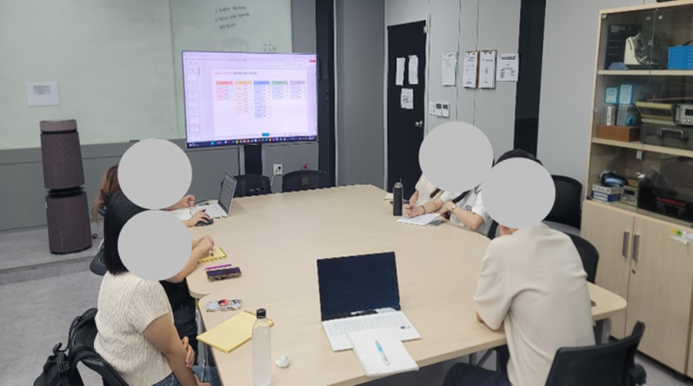
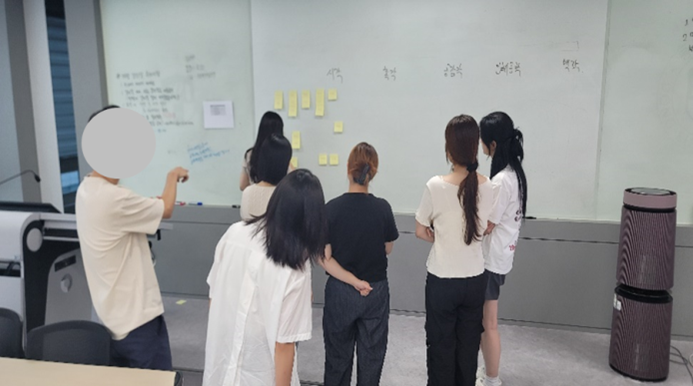
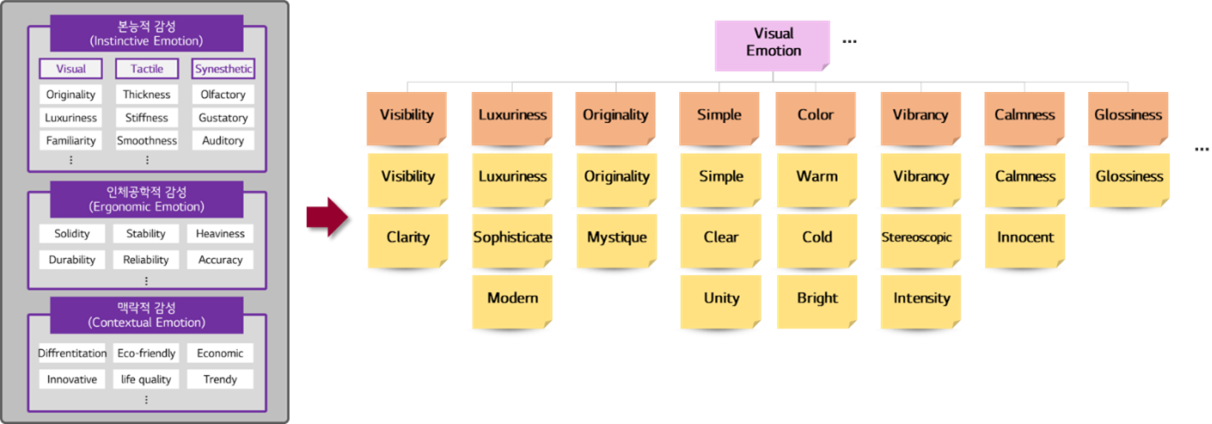
그 결과 Table 4와 같이 '본능적 감성' 중 시각 8개, 촉각 4개, 공감각 3개, 그리고 '인체공학적 감성' 3개, '맥락적 감성' 4개로 모두 22개의 가전 제품 타겟 지표(Specific Indexes on Home Appliance)로 정리되었다. 즉, 일반적 지표 69개 중에서 가전 제품을 타겟으로 그룹핑을 한 결과 22개로 추려진 것으로 해석할 수 있다.
|
Instinctive
emotion |
Ergonomic |
Contextual |
|||
|
Visual |
Tactile |
Synesthetic Emotion |
|||
|
독창감 (originality) |
생동감 (vibrancy) |
표면감 |
청각감 |
내구성 (durability) |
쾌적감 (pleasantness) |
|
고급감 (luxuriness) |
차분감 (calmness) |
안락감 (comfortness) |
미각감 |
안전감 |
활용성 (usability) |
|
심플감 (simplicity) |
표면감 |
온도감 |
후각감 |
사용감 |
조화감 |
|
시인감 (visibility) |
색상감 |
견고감 (solidity) |
|
|
혁신성 (innovativeness) |
3.2.2 2nd Specific index organization by fitness analysis on kitchen appliance
Method description
앞 단계에서 가전 제품의 CMF 디자인을 대상으로 할 때 관련될 수 있는 평가 지표로 22개로 추려졌다. 다음으로 이 22개에 대하여 일반 사용자들 대상으로 적합한 정도를 분석하였다. 즉, 각 지표가 가전 제품의 CMF 관점에서 볼 때 CMF 요소를 표현하는데 얼마나 적합한지를 평가한 것이다. 이를 통해 점수가 낮은 지표들은 이후 가전 제품의 CMF 평가 지표로서 사용이 어렵다는 판단이 가능한 것이다. 그리고 최종 적용 가능한 지표를 도출하는 과정이고 일반 사용자들이 적합성을 판단하는데 더 명확한 정보를 제공하기 위하여 가전 제품들 중에서 대표적인 제품군이라 할 수 있는 냉장고, 전기오븐, 토스터 등의 주방용 제품군으로 Targeting을 하여 이것을 대상으로 평가하였다.
일반 사용자 36명이 참여하였으며 남성 18명, 여성 18명으로 구분되었다. 나이대는 미래의 높은 구매력과 트렌드에 민감한 세대라는 특징(Sung and Nah, 2018)이 있는 20대를 중심으로 하되(24명), 현재 구매력이 높은 30대(Open Survey, 2022)를 보완하는 정도로 진행하였다(12명). 그렇게 해서 참여자 전체의 평균 연령은 29.67세였다.
Evaluation process
평가 진행 과정은 다음과 같다.
(1) 평가 대상 제품군 구성: 주방 내 위치하고 사용 빈도가 높으며 다양한 CMF 측면을 검토할 수 있다고 연구진이 판단한 냉장고, 전기오븐, 토스터기로 선정함
(2) 평가지 개발
- 22개 지표와 각 설명이 표시되고 지표별로 적합도 평가 점수를 입력하도록 함(Table 5)
- 평가 대상 제품군에 대한 명확한 인식을 위하여 대표 사진을 포함시키고 CMF 요소에 대한 감성 평가 시 7점 Likert's Scale를 활용한 기존 연구에 근거하여 전혀 적합하지 않다(1점)-매우 적합하다(7점)으로 응답하도록 함(Na et al., 2012; Choi et al., 2006) (Figure 8)
- Microsoft社의 Excel 프로그램에 직접 입력할 수 있도록 개발함
(3) 참여자 모집: 냉장고, 전기오븐, 토스터기를 가정에 보유한 일반 사용자이며, 실제 평가 시 가정에 있는 제품들을 보면서 평가하는 것이 가능한 참여자로 모집함
(4) 평가 진행: 평가지로서의 Excel 파일을 각자 가정에서 실 제품들을 보면서 지표별로 적합성 평가를 진행함. 메일이나 메신저 서비스로 평가 파일을 전달하고 평가 결과 파일로 전달받았음.
|
Major |
Middle |
Minor category |
Meaning |
Rating |
|
Instinctive |
Visual |
독창감 (Originality) |
When viewing the CMF elements of a
product with the |
|
|
고급감 (luxuriness) |
The degree to which a product feels
luxurious when looking at its CMF elements with the naked eye |
|
||
|
심플감 (simplicity) |
The degree to which the CMF
elements of a product feel |
|
||
|
시인감 (visibility) |
The degree to which the shape or
color of a product's CMF elements is easily visible to the naked eye. |
|
||
|
생동감 (vibrancy) |
The degree to which a product feels
dynamic when viewing its CMF elements with the naked eye |
|
||
|
차분감 (calmness) |
The degree to which the product
calms and calms the mind when viewing its CMF elements with the naked eye. |
|
||
|
표면감 |
The degree to which a glossy or
matte feeling is felt on the surface of a product when viewing the CMF elements
of |
|
||
|
색상감 (sense of color) |
The degree of warmth, brightness,
and coolness felt in the color of the product when viewing the CMF elements
of |
|
||
|
Tactile |
표면감 (sense of surface) |
The degree of smoothness,
roughness, matteness, stiffness, or softness of the product surface felt by
the skin. |
|
|
|
안락감 (comfortness) |
The degree to which the skin feels
soft or elastic when touched and the body and mind feel comfortable |
|
||
|
온도감(sense of temperature) |
How warm or cool the product feels
when it touches or touches the skin |
|
||
|
견고감 (solidity) |
The degree to which the product is
firm and feels thick |
|
||
|
Synesthetic |
청각감 |
Emotions felt through the acoustic
effects of sound that appear according to the characteristics of the CMF
itself |
|
|
|
미각감 |
Sensitivity to the taste of the
main ingredients that appears according to the characteristics of CMF itself |
|
||
|
후각감 |
The emotion felt through the scent
is realized by incorporating the scent into the CMF itself. |
|
||
|
Ergonomic emotion |
내구성 (durability) |
It does not corrode easily and is
highly durable with little damage or scratches even when external shock occurs. |
|
|
|
안전감 (sense of safety) |
The degree to which it is safe and
reliable, with no risk of danger or accident. |
|
||
|
사용감 (sense of use) |
The degree to which the product is
clearly usable so that users can use it easily, and the product is convenient
to move and user-friendly. |
|
||
|
Contextual emotion |
쾌적감 (pleasantness) |
The degree to which you feel
refreshed and happy and can improve your quality of life |
|
|
|
활용성 (usability) |
It can be used in many ways and is
practically usable. |
|
||
|
조화감 (sense of harmony) |
The degree to which the product
fits evenly into the space where it is placed without being misaligned or
clashing |
|
||
|
혁신성 (innovativeness) |
The extent to which a product is
innovative and completely modified to become different and symbolic. |
|
||
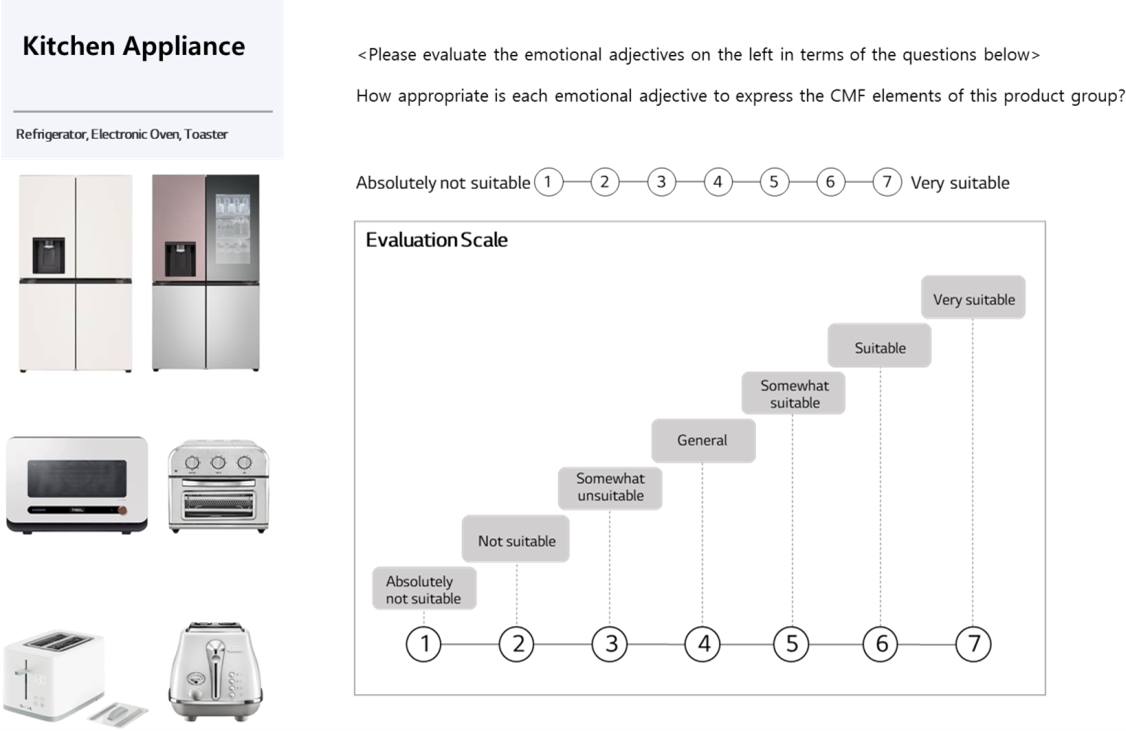
Results
32명의 일반 사용자가 평가한 적합도 점수 데이터로부터 One-way ANOVA와 S-N-K (Student-Newman-Keuls) 사후 분석을 실시하였다. 유의수준은 5%로 설정하였으며, 이 분석에는 IBM SPSS Statistics 26.0 버전을 사용하였다. 그 결과는 Figure 9에 나타내었다.
즉 시각적 감성은 모두 4개의 유의한 차이가 나는 그룹으로 분류되었으며 그 중에서 고급감과 심플감이 가장 높은 적합도를 보이는 그룹이었다. 촉감적 감성은 3개의 그룹으로 구분되었으며 견고감이 가장 적합도가 높았다. 공감각적 감성은 상대적으로 낮은 적합도와 함께 유의한 그룹차이가 나타나지 않았다. 또한 인체공학적 감성도 1개 그룹으로만 분류되어 유의한 차이가 없었으며, 맥락적 감성은 3개 그룹으로 분류되었다.
이 결과는 주방 가전 제품 타겟 최종 특정 지표(Final Specific Indexes on Kitchen Appliance)로 정의하였으며 22개로 추려진 특정 지표에 대해 주방용 가전 제품군을 대상으로 할 때 사용할 수 있도록 정량적으로 우선 순위가 부여된 것이다. 이 최종 특정 지표를 사용할 상황에 따라 우선 순위가 높은 것부터 사용 범위를 정하여 활용할 수 있는 것이 된다.
또한 동일한 인원으로 구분된 남녀간의 적합도 결과에 차이가 있는지 확인을 위하여 2-Sample t-test를 한 결과 p-value = 0.33으로 통계적으로 유의한 차이는 없는 것으로 나왔다. 이로부터 최종 지표에 부여된 우선 순위에 대해서는 남녀간 차이 없는 공통적인 결과라고 판단할 수 있다. 그리고 연령대별 차이는 샘플의 수가 연령대별로 동일하지 않음을 고려하여 추가로 분석하지 않았다.
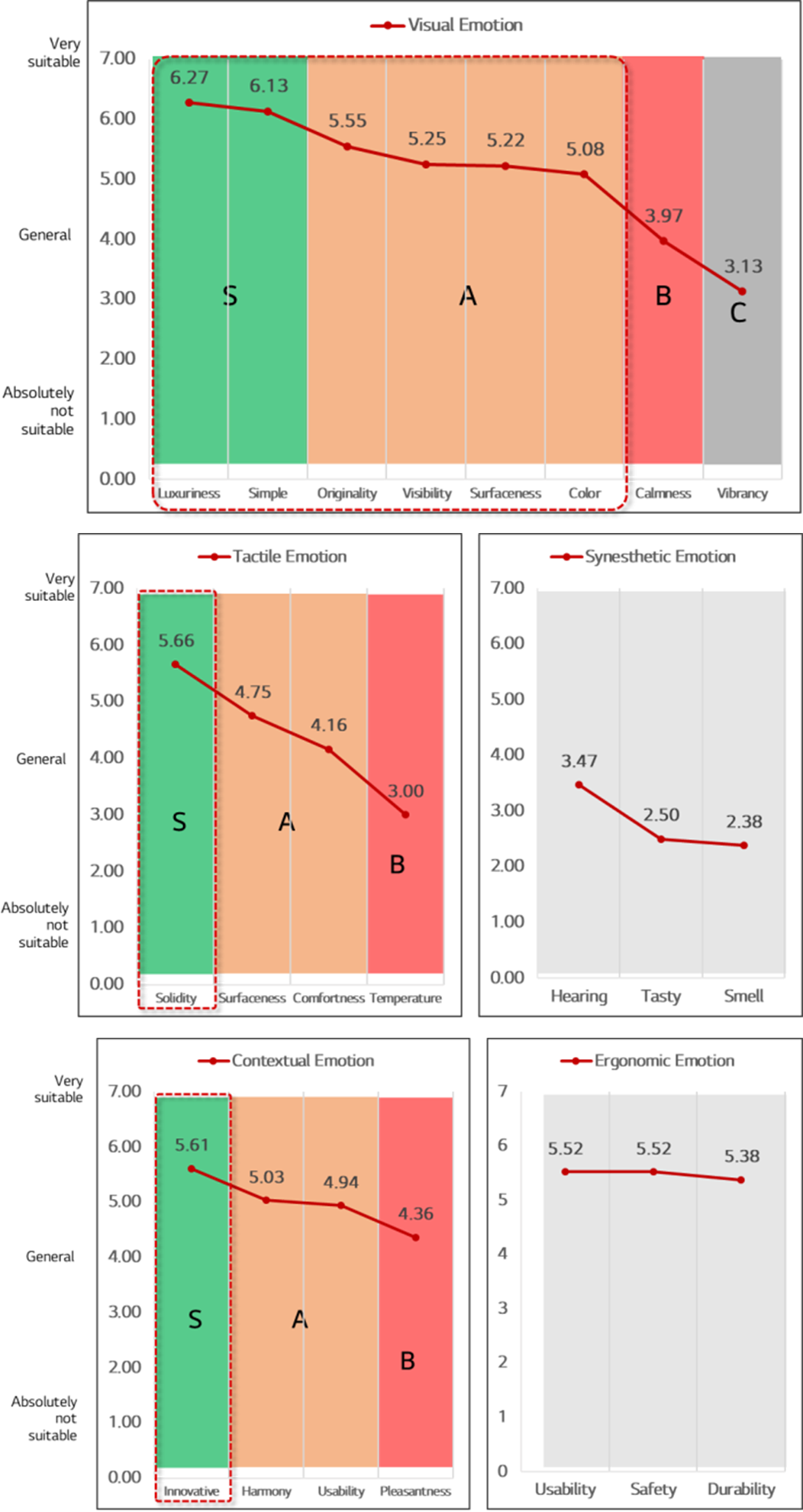
본 연구는 CMF디자인이 적용된 제품에 대하여 사용자가 느끼는 경험 품질을 평가하기 위한 지표를 개발한 것이다. 이 연구 핵심은 실제 연구나 실무에 사용할 수 있는 평가 지표를 도출하는 것이며, 그렇다 보니 지표를 정리하며 도출해 나가는 과정의 체계성도 중요한 포인트였다. 그래서 연구를 크게 2개 단계로 나누어서 체계적으로 접근하였다. 첫 번째 단계에서는 기본 데이터 수집부터 1차 결과물로서 최종 지표를 도출하였다. 먼저 체계적 문헌 고찰 보고지침에 기반한 PRISMA 방법으로 문헌을 선별하여 평가 지표의 기본 데이터를 수집하였다. 그 결과에 대하여 친화도법(Affinity Diagram)에 기반하여 정리하고 또한 전문가 리뷰(Expert Review)의 검증을 거쳐 1차 결과물로서의 최종 지표(Final Indexes)를 도출하였다. 이 최종 지표는 세부 지표가 69개로 모두 평가 지표로 사용할 수 있는 것이고 평가 대상물에 따라 선택적으로 사용할 수 있는 것이었다. 두 번째 단계에서는 2차 친화도법을 수행하고 22개의 세부 지표를 도출하고, 이 지표들에 대해 주방 가전 제품군 관점에서 CMF 디자인 경험 품질과의 적합도 분석(Fitness Analysis) 평가를 수행하였다. 그리고 그 결과에 대해 ANOVA를 실시하여 우선 순위로 정리된 최종 지표를 도출하였다. 이 지표는 특정 제품군(주방 가전)의 관점에서 실제 사용할 수 있는 지표로 정리한 것이라고 할 수 있었다.
이상의 연구는 기존에 제품 평가, 평가 체계, CMF 디자인, CMF 디자인 제품 등에 대한 연구는 많지만 CMF 디자인이 적용된 제품에 대한 경험 품질 평가에 대한 연구는 부족한 상황에서 이에 대한 체계적인 연구를 진행하고 실제 적용 가능한 지표를 도출하였다는데 의미가 있다. 그리고 본 연구에서 도출한 69개의 일반적 지표는 모든 CMF 디자인 제품에 적용 가능한 데이터베이스 역할을 할 수 있으며, 주방 가전 제품군 대상의 지표들은 해당 제품의 CMF 디자인 경험 품질 평가 시 우선 순위에 따라 선택하여 바로 적용할 수 있다. 그 외 제품들에 대해서도 해당 제품과의 적합도 평가를 통해 선택적으로 적용 가능하여 관련 연구나 실무에서의 현장 적용성이 높다는데 의미가 있다.
향후에는 주방 가전 제품군 외 다양한 제품군에 대해서도 바로 적용할 수 있는 우선 순위화된 지표를 도출하는 연구도 진행될 수 있을 것이다. 또한 적합성 평가의 최종 결과에서 나온 Oneway-ANOVA 결과의 그룹이 전체 지표를 축소화해서 사용하는 용도로 사용할 수 있으므로 전체 지표를 이용하는 것과 축소화된 지표를 이용하는 부분도 추후 연구로 진행될 수 있을 것이다.
References
1. Bae, S.H., Shin, J.G., Huh, I.S. and Kim, S.H., A Study on Qualitative Usability Assessment Guideline of the Wearable Industrial Robots for Interacting with the Upper Extremities, Journal of the Ergonomics Society of Korea, 39(2), 129-141, 2020.
PIDS App ServiceClick here!